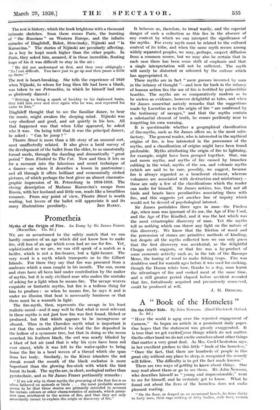Prometheia
Myths of the Origin of Fire. An Essay by Sir James Frazer. (Macmillan. 12s. 6d.) WE are so accustomed to the safety match that we can hardly conceive of an age which did not know how to make fire, still less of an age which even had no use for fire. Yet, sophisticated as we are, we can still speak of a match as a
lucifer, which is not a fire-bearer, but a light-bearer. The very word is a myth which transports us to the Gilbert Islands. For there they say that fire was procured from a sunbeam which a man caught in his mouth. The sun, moon and stars have all been laid under contribution by the maker of myths, but it is only civilized man who makes the mistake of asking for a light when he means fire. The savage weaves exquisite or fantastic myths, but fire is a tedious thing for him to produce : so when he means fire, he says it and is under no illusion that heat is necessarily luminous or that there must be a warmth in light.
The fire-myth, then, represents the savage in his least realistic mood—and it may well be that what is most relevant in these myths is not just how fire was first found, filched or produced, but that which appears to be incongruous or absurd. Thus in the Cherokee myth what is important is not that the animals plotted to steal the fire deposited in the hollow of a sycamore tree, but that in doing so the raven scorched his feathers black, the owl was nearly blinded by a blast of hot air (and that is why his eyes have been red ever since); while it was left to the water-spider to bring home the fire in a bowl woven of a thread which she span from her body. Similarly, to the Kiwai islanders the red streak round the mouth of the black cockatoo is more important than the glowing fire-stick with which the bird burnt its beak. The myths are, in short, zoological rather than pyrotechnic, and as Sir James Frazer pertinently remarks :
" If we ask why in these myths the procuring of the first fire is so often fathered on animals or birds . . . the most probable answer seems to be that these stories are primarily intended to account for certain colours or other characteristics of animals, which primi- tive man attributed to the action of fire, and that they are only secondarily meant to explain the origin or discovery of fire."
It behoves us, therefore, to tread warily, and the especial danger of such a collection as this lies in the absence of any context by which we can interpret the significance of the myths. For every myth must be related to the cultural context of its tribe, and when the same myth recurs among widely separated peoples, we may, perhaps, suspect diffusion from a common source, but we may also be certain that in each case there has been some shift of emphasis and that a single interpretation will not be sufficient. The myth will surely be distorted or coloured by the culture which has appropriated it.
These myths are in fact " mere guesses invented by man in the infancy of thought "—and how far back in the infancy of human action lies the use of fire is testified by palaeolithic hearths. The myths are so comparatively modern as to be useless as evidence, however delightful as tales, and when Sir James somewhat naively remarks that the suggestions made by Lucretius as to the origin of fire " are confirmed by the testimony of savages," and that the myths contain a substantial element of truth, he comes perilously near to forgetting his own warning.
It is questionable whether a geographical classification of fire-myths, such as Sir James offers us, is the most satis- factory. The general reader, who is interested in the mythical origins of fire, is less interested in the provenance of the myths, and a classification of origins might have been found preferable. Myths attributing the origin of fire to lightning, for example, might have been grouped together. Star, sun and moon myths, and myths of fire caused by branches rubbing in the wind, myths of the sea, and volcanic myths (which are said to be rare, possibly, we suggest, because fire is always regarded as a beneficent element, whereas volcanoes are associated with destruction and misfortune)— these are only a few of the classifications which the reader can make for himself. Sir James notices, too, that not all birds and beasts have peculiarities associating them with fire, and this suggests yet another line of inquiry which would not be devoid of psychological interest.
Sir James postulates three ages in man—the Fireless Age, when man was ignorant of its use, the Age of Fire Used, and the Age of Fire Kindled, and it was the last which was the most catastrophic discovery of man. Yet the myths tell us nothing which can throw any light on the nature of this discovery. We blow that the friction of wood and the percussion of stones are primitive methods of kindling, but despite all the myths collected here we can only guess that the first discovery was accidental, as the delightful Chagga myth suggests, or that fire was a by-product of some economic activity such as, in the tale of the Basongo Meno, the boring of wood to make fishing traps. Fire was doubtless used for warmth ages before it was used for cooking, though the Dusun relate how, thanks to a dog, man learnt the advantages of fire and cooked meat at the same time, and a still greater period elapsed before accident revealed that fire, fortuitously acquired and precariously conserved,














































 Previous page
Previous page